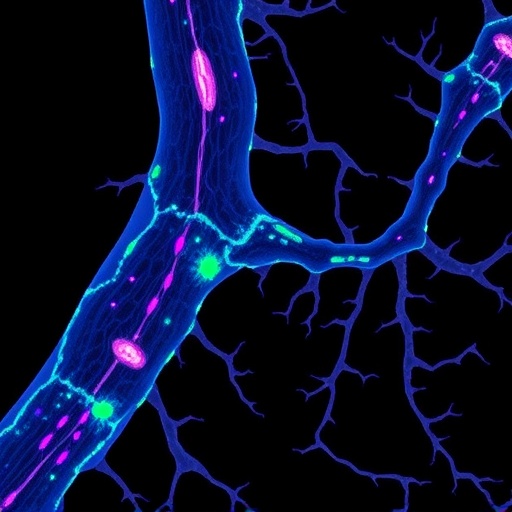In a groundbreaking advance that could shift the paradigm of triple-negative breast cancer therapy, researchers have unveiled promising results from the investigation of a wasp venom-derived peptide, MP-1, as a targeted agent against PD-L1. This discovery, detailed in a recent publication, leverages both in silico and in vitro methodologies to validate the therapeutic potential of MP-1, offering new hope for addressing one of the most aggressive forms of breast cancer. The study thrusts forward the exciting prospect of venom peptides as viable molecular weapons in the ongoing fight against malignancies that currently elude effective targeted treatments.
Triple-negative breast cancer (TNBC), characterized by the absence of estrogen, progesterone, and HER2 receptors, poses a significant clinical challenge due to its limited therapeutic options and poor prognosis. Unlike other breast cancer subtypes, TNBC does not respond to hormonal therapies or HER2-targeted drugs, making immunotherapy a critical yet complex frontier. PD-L1, a protein expressed on tumor cells that helps them evade immune destruction, has become an attractive target, but therapies exploiting this immunological checkpoint have met obstacles regarding efficacy and safety. The quest for novel agents that can inhibit PD-L1 while sparing healthy tissues is therefore of paramount importance.
The current study employs a multidisciplinary approach, integrating bioinformatics and laboratory experiments to confirm the binding efficacy and anticancer activity of the peptide MP-1. Utilizing advanced molecular docking simulations, the researchers first predicted the interaction between MP-1 and the PD-L1 receptor, unveiling a strong affinity and precise binding sites that suggest a mechanism for immune checkpoint interference. These simulations are critical in drug design, allowing for the rapid screening of candidate molecules before moving to costly and time-consuming experimental procedures.
Subsequently, the researchers transitioned to in vitro assays to validate the bioinformatics predictions. They evaluated the peptide’s capacity to inhibit PD-L1 expression on TNBC cell lines, observing significant downregulation post-treatment with MP-1. This reduction correlates with an enhanced activation of cytotoxic T cells in co-culture experiments, implying that MP-1 not only blocks the receptor but also effectively dismantles the tumor’s immune evasion tactics. Such dual functionality is essential for robust anticancer immune responses.
Importantly, the wasp venom peptide MP-1 presents unique structural characteristics that make it an alluring candidate for drug development. Peptides derived from venomous species often possess selective cytotoxic properties and can be engineered for improved stability and reduced toxicity. MP-1’s relatively small size and specific amino acid sequence confer it with the ability to permeate tumor microenvironments and disrupt molecular interactions critical for cancer cell survival without extensive off-target effects.
The research team also highlighted the potential biosafety advantages of utilizing venom-derived peptides. Traditional chemotherapeutic agents frequently carry severe side effects due to their non-specific action on dividing cells, while immune checkpoint inhibitors can trigger autoimmune reactions. By contrast, MP-1 appears to exert its effects primarily through direct molecular interactions with PD-L1, providing a targeted approach that may minimize collateral damage and improve patient quality of life.
This investigation answers a pressing need in oncology: to find new molecular entities capable of overcoming the notorious heterogeneity and adaptability of TNBC. The combination of computational models with empirical validation, as performed here, underscores the modern trend toward integrated drug discovery pipelines that enhance both speed and precision. The results suggest that venom peptides warrant extensive exploration beyond classical chemotherapeutics and monoclonal antibodies.
The study also paves the way for the development of combination therapies. MP-1’s ability to modulate the tumor immune microenvironment could potentiate existing immunotherapies or chemotherapies, rendering resistant tumors more susceptible to eradication. Future research will need to explore these synergistic potentials in animal models and clinical trials, an endeavor that the authors advocate due to their promising early findings.
Moreover, by dissecting the peptide’s mechanism of binding and inhibition at a molecular level, the study contributes crucial insights into the architecture of immune checkpoint proteins themselves. Understanding how MP-1 interferes with PD-L1’s interaction with its receptor PD-1 elucidates novel binding pockets and structural weaknesses that can be exploited to design even more effective inhibitors. This knowledge enriches the broader scientific community’s arsenal against various cancers beyond TNBC.
The implications of this research are not limited to oncology. The application of venom peptides in medicine represents a rapidly evolving field, with potential utility in infectious diseases, autoimmune disorders, and neurodegenerative conditions. By establishing a successful precedent in TNBC, the study invigorates interest in natural products as drug leads, encouraging multidisciplinary collaborations among biochemists, pharmacologists, and clinicians.
In conclusion, the validation of the wasp venom peptide MP-1 as a PD-L1 targeting agent in triple-negative breast cancer marks a milestone in the quest for novel immunotherapeutics. While challenges remain in translating these findings from bench to bedside, the combination of computational design and experimental rigor demonstrated in this investigation exemplifies the future of cancer drug development. With further refinement and clinical validation, MP-1 or its derivatives could become integral components of personalized cancer treatment regimens, bringing renewed optimism to patients with limited options.
As the global cancer research community embraces the era of precision medicine, studies such as this one reinforce the essential role of innovative biomolecules sourced from nature’s own arsenal. The integration of venom peptides into therapeutic strategies promises not only new frontiers in efficacy but also safer, more tolerable interventions. MP-1’s journey from wasp venom to potential cancer therapy embodies this exciting transformation, underscoring how understanding and harnessing the complexity of biological systems can yield life-saving medical breakthroughs.
Subject of Research: Targeting PD-L1 in triple-negative breast cancer using wasp venom-derived peptide MP-1 for immunotherapeutic applications.
Article Title: PD-L1 targeting in triple negative breast cancer: in silico and in vitro validation of wasp venom peptide MP-1.
Article References:
Sakhawat, A., Khan, M.U., Khan, S. et al. PD-L1 targeting in triple negative breast cancer: in silico and in vitro validation of wasp venom peptide MP-1. Med Oncol 43, 14 (2026). https://doi.org/10.1007/s12032-025-03133-1
Image Credits: AI Generated
DOI: https://doi.org/10.1007/s12032-025-03133-1
Tags: aggressive breast cancer therapiesimmune evasion in tumorsimmunotherapy challenges in TNBCin silico and in vitro methodologiesmolecular weapons against malignanciesnovel cancer treatment strategiesPD-L1 targeting agentstargeted treatments for TNBCtherapeutic potential of MP-1triple-negative breast cancer therapyvenom peptides in oncologywasp venom peptide MP-1





